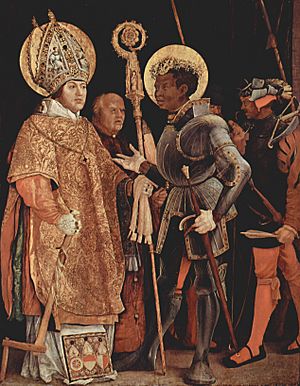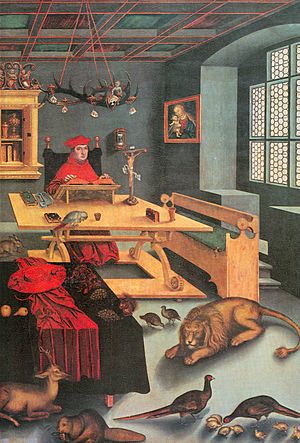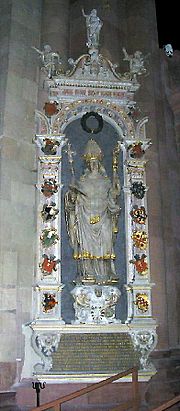Albert of Brandenburg facts for kids
Quick facts for kids His Eminence Albert of Brandenburg |
|
|---|---|
| Archbishop of Mainz | |

Portrait by Lucas Cranach the Elder, 1526
|
|
| Church | Roman Catholic |
| Archdiocese | Electorate of Mainz |
| In Office | 1514–1545 |
| Predecessor | Uriel von Gemmingen |
| Successor | Sebastian von Heusenstamm |
| Orders | |
| Ordination | 4 April 1513 |
| Consecration | 2 July 1514 by Dietrich von Bülow |
| Created Cardinal | 24 March 1518 |
| Personal details | |
| Born | 28 June 1490 Kölln |
| Died | 24 September 1545 (aged 55) Martinsburg, Mainz |
| Signature | |
Cardinal Albert of Brandenburg (German: Albrecht von Brandenburg; June 28, 1490 – September 24, 1545) was an important German church leader. He was a cardinal, an elector (a powerful prince who chose the Holy Roman Emperor), and an Archbishop of both Mainz and Magdeburg.
Albert became a key figure in the start of the Reformation because of his role in selling special church pardons, called indulgences. He later became a strong opponent of Martin Luther and his new ideas.
Contents
Biography
Becoming a Church Leader

Albert was born in Kölln (now part of Berlin). He belonged to the powerful House of Hohenzollern. His older brother, Joachim I Nestor, became the Elector of Brandenburg.
Albert studied at the University of Frankfurt (Oder). In 1513, when he was just 23, he became the Archbishop of Magdeburg. He also managed the Diocese of Halberstadt.
In 1514, Albert was chosen to be the Archbishop of Mainz. This made him the ruler of the Electorate of Mainz and a very important official in the Holy Roman Empire. The church leaders in Mainz hoped he would help protect their city, Erfurt.
However, Albert's appointment broke church rules. A person was not supposed to be in charge of more than one church area (bishopric). Also, Albert was too young and didn't have a college degree. He received special permission to take on these roles.
Albert borrowed a lot of money, 20,000 guilders, from a rich banker named Jacob Fugger. He needed this money to pay a large fee to the Pope's office in Rome.
In 1514, Albert suggested to Pope Leo X that they sell special indulgences in his church areas. Half of the money from these sales would go to build the new St. Peter's Basilica in Rome. The other half would go to Albert. The Pope agreed in 1515.
Albert hired a preacher named Johann Tetzel to sell these indulgences. Tetzel's methods were very controversial. This led Martin Luther to write a letter of protest to Albert in 1517.
Albert and the Reformation
Luther's protest letter included his famous 95 Theses. These ideas led to the start of the Protestant Reformation. Luther sent these theses to Albert on October 31, 1517. Albert then sent them to Rome, thinking Luther was spreading wrong religious beliefs.
In 1518, Albert became a cardinal at age 28. When the election for the Holy Roman Emperor came in 1519, Albert's vote was very important. Supporters of the two main candidates, Charles I of Spain and Francis I of France, offered Albert a lot of money for his vote. The electors eventually chose Charles, who became Emperor Charles V.
Albert was interested in new ideas and was friends with important thinkers. Some people hoped he might support the new Protestant movement. But after a big uprising by farmers in Germany in 1525, Albert firmly supported the Catholic Church. He joined a group of Catholic princes called the League of Dessau.
From 1514 until 1541, Albert mostly lived in Halle. He built a large new palace there in 1531. He also wanted a grand church in Halle. Albert collected over 8,100 holy items and 42 holy skeletons. These needed a place to be stored.
He had two old churches torn down, keeping only their four towers. Between these towers, he built a large new church called the Market Church of Our Lady. This church was dedicated to the Virgin Mary. These valuable treasures, known as the Halle sanctuary, were meant to attract pilgrims who would pay to see them. This was linked to the sale of indulgences that had started the Reformation. Albert and the Catholic city leaders wanted to stop the spread of the Reformation. They hoped grand church services in the new church would help.
Albert was not as extreme against the reformers as his brother Joachim I. He tried to keep the peace. However, new Protestant ideas spread in his lands. He had to grant religious freedom to the people of Magdeburg in exchange for a large sum of money. Later in his life, he became less tolerant of Protestants. He favored the teachings of the Jesuits, a new Catholic religious order.
The Market Church of Our Lady in Halle was built to fight against the Reformation. But in 1541, Justus Jonas officially brought the Reformation to Halle with his sermon there. Albert left Halle for good after the city's important people said they would take over his huge debt to the Fugger bank. Halle became Protestant.
Albert as a Patron of the Arts

Albert was a friend of science and a great supporter of the arts. He was friends with the famous scholar Erasmus. Albert wanted to build a Catholic university in Halle, but this never happened.
He spent a lot of money decorating Halle Cathedral and Mainz Cathedral. His motto was "I have loved, O Lord, the beauty of thy house." Famous artists like Matthias Grünewald and Lucas Cranach the Elder created beautiful paintings for Halle Cathedral. Cranach and his workshop painted 140 pictures for 16 altars, which was a huge project. Grünewald created the famous wood painting Saint Erasmus and Saint Maurice. Albert also ordered paintings from Hans Baldung Grien. In 1526, he donated the market fountain in Mainz.
When Albert left Halle in 1541, he moved to Aschaffenburg. He took his collection of holy items and his private art collection with him. He also took many artworks he had given to churches that were now becoming Protestant. He sold some of the holy items to pay off debts.
His private paintings were kept at Johannisburg Castle. Many were lost or destroyed during a war in 1552. The artworks from Halle Cathedral were moved to the St. Peter und Alexander's church. They survived many wars there. Today, they can be seen in the reconstructed castle in the Staatsgalerie Aschaffenburg. This collection is considered the largest collection of Cranach's works in Europe.
Death
Albert died at the Martinsburg, Mainz in 1545. His tomb is in Mainz Cathedral.
Images for kids
See also
 In Spanish: Alberto de Brandeburgo para niños
In Spanish: Alberto de Brandeburgo para niños










